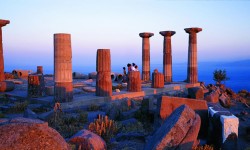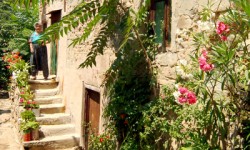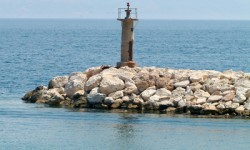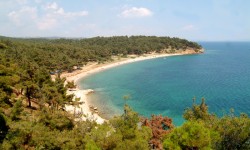


The province of Canakkale lies on both sides of the Dardanelles which connects
the Sea of Marmara to the Aegean Sea. Its shores touch both Europe (with the Gelibolu Peninsula) and Asia (with the Biga Peninsula) and there are regular ferries between the two sides. The Canakkale Marina, besides those of
Karabiga, Gelibolu, Bozcaada and Kucukkuyu, hosts the colorful yachts which pass through the strait and make a stopover at Canakkale, to see this historical and mythological rich area, homeland of many widely known legends. There
is a new pier built in Kepez district of Canakkale, with bulk, general, passenger, Ro-Ro, warehouse and open storage facilities. It is the nearest passenger terminal to Troy for cruise ships. Canakkale has a nice archaeological
museum with many objects distributed in 5 different halls.
Troy
Troy is a city which existed over 4.000 years and known as the center of ancient civilizations. For many
years people believed that it was the city mentioned only in the tales and never existed until it was first found in the 19th century. Troy (Truva in Turkish) is located in Hisarlik near Canakkale province where the remains of
this once-great city can be visited. What was left are the remains of the destruction of Schliemann, the famous German archaeologist or a treasure hunter as some people call him. Today, an international team of German and
American archaeologists bring the Troy of the Bronze Age back to life under a sponsored project by Daimler - Benz, and another Turkish team is at law wars with Russia and Germany to get back the stolen Trojan treasures.
Troy appeared in Greek and Latin literature. Homer first mentioned story of Troy in Iliad and Odyssey. Later, it became the most popular subject in Greek drama. The book of Virgil's Aeneid contains the best known
account of the sack of Troy. In addition, there are untrue stories under the names of Dictys Cretensis and Dares Phrygius.
In the Bronze age, Troy had a great power because of its strategic location between
Europe and Asia. In the 3rd and 2nd millennia BC Troy was a cultural center. After the Trojan War, the city was abandoned from 1100 to 700 BC. About 700 BC Greek settlers began to occupy the Troas region, Troy was resettled and
named as Ilion. Alexander the Great ruled the area around the 4th century BC. After Romans captured Troy in 85 BC, it was restored partially by Roman general Sulla and named as New Ilium. During the Byzantine rule, Troy lost its
importance.
The ruins of Troy were first found by Charles McLaren in 1822. The German archaeologist Heinrich Schliemann excavated Troy from 1870 to 1890. His theft of treasure from Troy and his damage to the
site will be always remembered in Turkish archaeological history. Wilhelm Dorpfeld followed to excavate Troy after Schliemann. Today, a new German team is still working to rebuild Troy ruins by using new advanced technologies
since 1988. There are nine levels at Troy; Troy I to V relates roughly with early Bronze Age (3000 to 1900 BC). Its inhabitants were known as Trojans in this period. Troy VI and VII were built in the Middle and Late Bronze Age.
Troy VIII to IX belongs to Hellenistic and Roman Ilion (Latin Ilium). Troy was destroyed many times and rebuilt each time.
Troy is one of the most famous cities in the history, reminding us Hector, Achilles and
Achaean Greeks, the sake of Helen, Paris, Agamemnon and Priam. Its story is written in every language, Trojan heroes, Achilles' heel and Odyssey became figures in poems. From Alexander the Great to Lord Byron, many important
figures of the history stood on the site of the great heroes. However, people always wondered whether the Trojan War happened or not, or if there was really a wooden horse or not.
Gallipoli
The Gallipoli campaign took place between April and December 1915 in an effort to take the Dardanelles from the Turkish Ottoman Empire (an ally of Germany and Austria) and thus force it out of the war. Some 60,000
Australians and 18,000 New Zealanders were part of a larger British force. Some 26,000 Australians and 7,571 New Zealanders were wounded; and 7,594 Australians and 2,431 NZs were killed. In numerical terms Gallipoli was a minor
campaign but it took on considerable national and personal importance to the Australians and New Zealanders who fought there.
The Gallipoli Campaign was Australia's and New Zealand's introduction to the
Great War. Many Australians and New Zealanders fought on the Peninsula from the day of the landings (April 25, 1915) until the evacuation of 20 December 1915. The 25th April is the New Zealand equivalent of Armistice Day and is
marked as the ANZAC day in both countries with Dawn Parades and other services in every city and town. Shops are closed in the morning. It is a very important day to Australians and New Zealanders for a variety of reasons that
have changed and transmuted over the years.

















